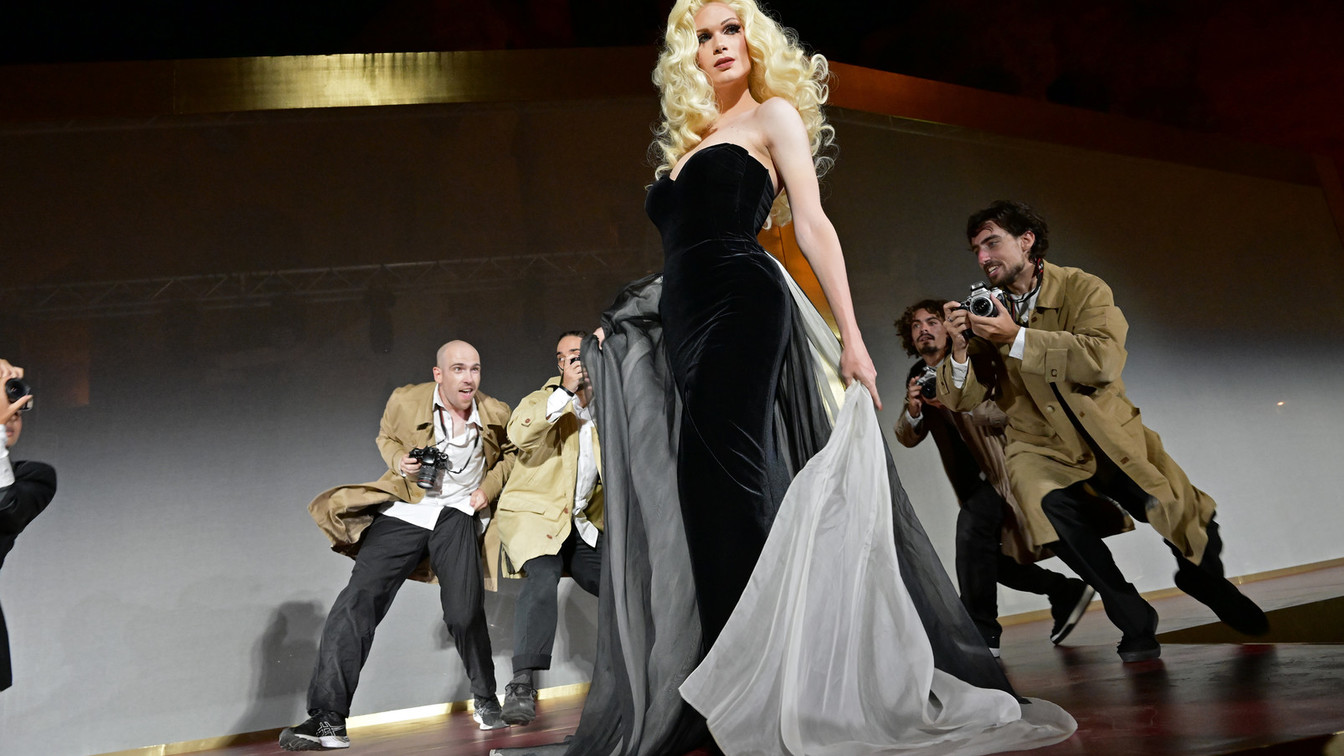

Paparazzi, flashing lights and video cameras. The great cinema under the stars and the stars on the red carpet. La Dolce Vita returns to light up Via Veneto. A night of fashion Oscars in Rome in the name of 100% Italian-made environmental sustainability. Models, designers, actors, dancers and singers strut their stuff on the 30-meter stage in front of Porta Pinciana. Once again the lights go up on that street in Rome, made famous all over the world by Federico Fellini's masterpiece. Even the bars that were the 1960s haunts of celebrities and photographers hunting for a scoop are all dressed up.
A baby of just six months, peers out of his father's backpack and looks around curiously. He is still awake (despite it being past his bedtime). He is not to know that the sidewalk in the 'Via del Cinema' was once trodden by the likes of Alberto Sordi, Ennio Flaiano and Frank Sinatra. Via Veneto was the hub of the global jet set: front page fights, stolen kisses, endless nights at Harry's bar. Each stretch of the road is a piece of history that comes back to life for one evening. Action!
“Marcello, come here,” whispers Anita Ekberg (the cult scene at the Trevi fountain), her voice rustling through the audience, and silence falls. Thus begins Roma è di Moda. Via Veneto Edition (event staged on Thursday 28 July), a tribute to Made in Italy, a trip down memory lane with firm focus on the future. A tribute to sustainability but without foregoing the glamor. (Priceless) jewelery alongside recycled materials. “We need a social pact with Creation. We must have the courage to repair, reuse and find a balance with the Earth,” the message launched by the guest of honor of the evening, the designer Brunello Cucinelli, ambassador of everything ‘Made in Italy’.
Old rubber—from discarded tires—collected by Ecopneus (a non-profit company) becomes part of the clothes on the catwalk. Bags created with x-rays (grabbed from the garbage) or coats sewn with VHS ribbons bear witness to the momentum towards the recovery of material that, second-hand, is transformed into high fashion.
Meanwhile, on the big screen above the stage, stardust sprinkles the images of the opening scenes of La Dolce Vita.
The evening show - conceived by Stefano Dominella with the artistic direction of Guillermo Mariotto and promoted by Roma Capitale—is the story of fine Italian craftsmanship, combining manufacturing tradition and eco-sustainable fashion with dance, acting and music.
Thus in Alessandro Consiglio's sophisticated eco-couture, old kitchen sponges become a seventeenth-century mesh that decorates a stunning outerwear garment.
The show—presented by Pino Strabioli and Ema Stokholma—opens with creations from Dominella's private historical archive including garments that are the fruits of the ingenuity of the most important couturiers in Italian high fashion: from Antonelli to Irene Galitzine, Fabiani, Valentino, Lancetti and Sarli.
Then other 'fashion works of art'—clothes by Lineapiù Italia, Alessandro Consiglio, Guillermo Mariotto, Francesca Liberatore and Federico Firoldi—in all, 100 dresses featured in the show directed by Rossano Giuppa.
Fashion goes hand-in-hand with art: etoile Alessio Rezza also takes to the stage with the dancers of the ballet corps from the Teatro dell'Opera in Rome.
Setting aside his camera—at least for the show—and model for an evening is the king of paparazzi Rino 'The King' Barillari (dressed as the Pope in the Guillermo Mariotto fashion show). “All the great personalities of entertainment,” he says with emotion, “have been in via Veneto. We paparazzi have made Rome famous all over the world.”
Auteur film is also on the red carpet. In fact, all eyes are on the original dress worn by Anita Ekberg in the fountain scene of the Oscar-winning film, accompanied on stage by the notes of the trumpet played by Michele Civitano and percussion by the TorQ Percussian Quartet. Then the attention shifts to Anna Magnani's dress in Risate di gioia (The Passionate Thief), worn by Paola Minaccioni.
Nancy Brilli (black dress with a sequined bodice) and Paola Minaccioni recite passages from works linked to Fellini, Flaiano and Anna Magnani.
‘Off-set', there is a coming and going of 'contemporary' VIPs: the first to arrive was Milly Carlucci.
La Dolce Vita in via Veneto concludes the July of the 'Renaissance' of Roman fashion which started with Valentino in Piazza di Spagna and continued with AltaRoma at the Campidoglio. Rome aims to return in style to the international scene and is ready for new projects in September. “The presence of Brunello Cucinelli, whose creations are a tribute to sustainable beauty,” explains Rome’s Councilor for Fashion and Tourism, Alessandro Onorato, “reflects the renewed focus of great international fashion on Rome.”
It’s getting late. Soft stage lights and the music is turned off. It's after 11 pm. After the glitz and glamor of one evening, Via Veneto returns to being one of the many locations affected by the problems of the Italian capital: traffic and garbage. But tomorrow—this is the hope—will perhaps be another story. At least for Cucinelli: “A life without hope lacks the reason to be lived. You are in the Eternal City, the most beautiful in the world. We must go back to looking after our places. The Athenians used to say that if the door of our house is clean, our city will also be clean.”